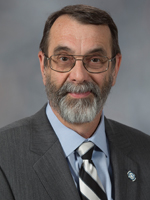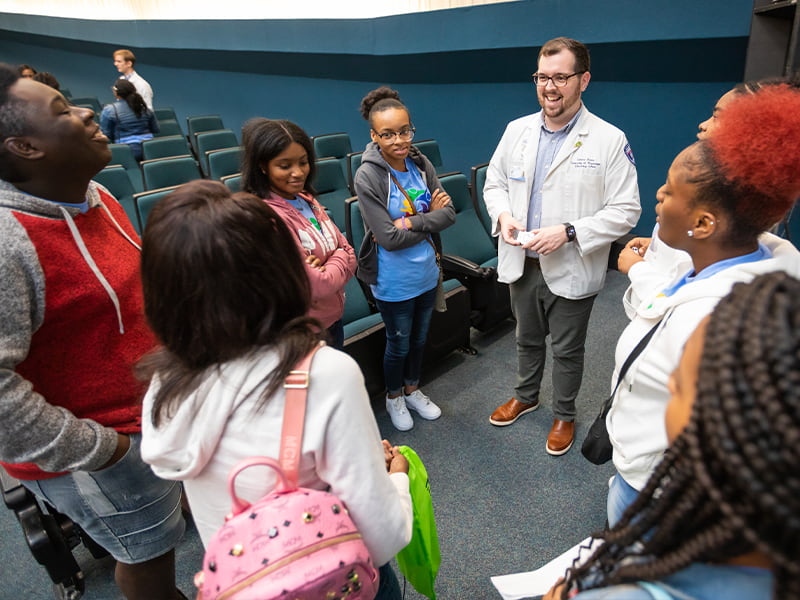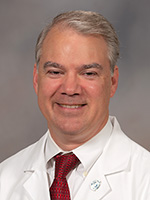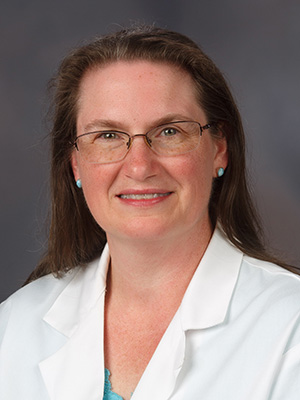Task force targets opioid crisis with information barrage

Scores of students at the University of Mississippi Medical Center have learned a life-saving measure meant to curb the deadly impact of a nationwide scourge.
Learners from several UMMC schools received hands-on instruction Friday in the administering of naloxone, brand name NARCAN®, a nasal spray that can force the dangers of an opioid overdose into retreat.
The interprofessional naloxone training, conducted in groups by students from the School of Pharmacy and held in the School of Medicine, is part of a cluster of recent or upcoming activities planned by the 37-member Opioid Task Force, established in 2018 by Dr. LouAnn Woodward, vice chancellor for health affairs and dean of the School of Medicine.
While the stated mission of the group is to help health care providers take a more considered approach to prescribing opioids for pain, its work also involves dosing health care workers and the public with information about opioid treatment – including the reversing effects of naloxone.

“It has saved lives and will continue to save lives,” said Dr. Rob Rockhold, professor of health sciences and deputy chief academic officer. “It’s been such a hot topic; we want to cast as wide a net as possible.”
The net was also cast over UMMC Grenada on January 29, when physicians and other health care workers heard an update on Mississippi Prescribing Guidelines and Diversion Prevention from Dr. Jessica Lavender, assistant professor of internal medicine, and Dr. Anthony Cloy, associate professor of medicine.
On February 12, during the annual Jackson Public Schools symposium, Youth Health Matters, the task force reached out to JPS 10th and 11th graders with lessons on administering naloxone. The teachers were mostly pharmacy students, and several medical students, led by Dr. Leigh Ann Ross, associate dean of the UMMC School of Pharmacy and director of the Center for Clinical and Translational Science.
Earlier this week in Tallahatchie County was the site of several events hosted by the School of Pharmacy’s CCTS and the University of Mississippi’s M Partner Initiative. First responders in the Charleston area embraced naloxone training from pharmacy students and Dr. Lauren Bloodworth, associate professor of pharmacy practice and the CCTS community population director.
Also in Charleston, at the Kennedy Wellness Center, area physicians, nurses, nurse practitioners and social workers were invited to a three-hour, opioid-abuse continuing education program featuring a discussion led by Cloy, Lavender and Dr. Ann Kemp, professor of medicine and task force chair.

And, for the residents of Charleston, the School of Pharmacy led a community-wide seminar on opioid abuse – an epidemic that, in 2017, the Department of Health and Human Services declared a public health emergency.
In a one-year period that ended in February 2019, an estimated 69,029 Americans died of a drug overdose, as reported by the National Center for Health Statistics. Almost seven out of 10 of those deaths are attributed to opioids, highly-addictive killers of pain that, when used wrong, can also kill the user.
Opioids include heroin, pain relievers such as oxycodone and hydrocodone, with brand names OxyContin® and Vicodin®, respectively, and synthetic concoctions such as the extremely potent fentanyl.
More than 200 suspected overdose deaths were reported to the Mississippi Bureau of Narcotics between 2017 and 2018. The number of opioid prescriptions dispensed in Mississippi in 2017 alone surpassed 3.3 million.
The majority of opioid addiction cases started with a legal prescription, Lt. John Harless of the MBN told students during last week’s naloxone session, which offered participants digital certification for their newly-acquired skills.
To better manage opioid abuse, Harless urged even closer cooperation between professionals in health care and law enforcement.

“Lt. Harless gave us a great perspective – from someone who’s working in the law enforcement field,” said Conner Ball of Madison, a first-year medical student.
“And [pharmacy student Douglas Dertien] did a good job in letting our groups be interactive and showing us how to use NARCAN the right way. I feel confident in using it now.”
NARCAN was patented in 1961 and approved for opioid overdose treatment by the Food and Drug Administration in 1971. “But until relatively recently, it was available by prescription only to qualified medical personnel,” Rockhold said.
Now, the overdose treatment is more readily obtainable for the public. “It’s available without a specific prescription,” Kemp said. “You can walk into a pharmacy and request it if you have concerns about yourself or someone in your family.
“This has been made possible because of a standing order from the Mississippi State Department of Health.”
Of course, it is important to get instructions on how to use it. This can come from the pharmacist who dispenses the product or at a session like this one, Kemp said.
“There are any number of reports of police officers, family members, and acquaintances providing naloxone in the home or in the field in emergencies and saving people's lives,” Rockhold said.

Saving a life can depend on recognizing the signs of an overdose, as described by fourth-year pharmacy student Mary Reagan Richardson to the assorted students attending Friday’s naloxone training activity: blue lips or nails, pale pallor, dizziness, confusion, drowsiness, choking and more.
As Richardson noted, naloxone is administered in more than one way, including by a hand-held auto-injector, Evzio®.
“Evzio comes with voice guidance – it tells you what to do. But the nasal spray is also easy to use and is less expensive, at least for now,” Kemp said. For the public, Evzio can cost several thousand dollars for two injectors, although there will be a generic injector in the future, Kemp said.
“NARCAN nasal spray is available at about $130 or $140,” said Dr. Justin J. Sherman, associate professor of pharmacy practice.
A generic nasal spray will be coming out soon, Kemp said. Its cost is estimated, but not confirmed, at $35.
Across the state, more than 9,000 law enforcement officers and first responders have been trained to administer NARCAN, said Mae Slay, outreach coordinator for a statewide initiative to end the opioid crisis: Stand Up, Mississippi, a partner of the task force and the Associated Student Body for Friday’s session.

For physicians worried that some patients are abusing opioid prescriptions, Dr. Patrick Kyle and Dr. William Gusa, assistant professor of anesthesiology and task force vice chair, are among the authors who collectively published recommendations for testing compliance.
Their article, published on pages 331-336 of the October 2019 issue of the Journal of the Mississippi State Medical Association, offers a vivid account of how some patients try to fake urine tests.

“Although many patients prescribed controlled substances use them responsibly and as directed by their providers, some do not,” said Kyle, assistant professor of pathology.
“Some patients are known to mix potentially harmful illicit drugs with prescribed opioids. But it’s not only illicit drugs that can be potentially dangerous when mixed with opioids.
“There is also a large black market for these drugs. Some people complaining of, say, chronic back pain, may actually be trying to obtain prescription medications they can sell on the street. Drug diversion can be very lucrative.
“We have patients coming into our hospital who have been prescribed those drugs and who know they are going to be tested in order to keep their prescriptions.”
In their JMSMA article, Kyle and his colleagues lay out urine specimen collecting guidelines meant to foil attempts to dilute or otherwise sully test results.
And, in particular, they describe the effectiveness of mass spectrometry testing – the “gold standard of techniques” which are more comprehensive and specific than many hospital’s traditional, and routine, drug screens, Kyle said.
Students and employees of Medical Center hospitals have the opportunity to learn more about drug diversion on February 25 during the ASB/Schwartz Center Rounds event, “This is Us: Shedding Light on Who is at Risk of Substance Use Disorder and Resources for Recovery.”
Scheduled for noon until 1 p.m. in the School of Medicine, room SM122, the presentation is “geared toward health care students, but is also open to providers,” said Reginald Funches, diversion control officer.
“They will also learn about the science behind drug addiction and where employees with an addiction can go to find resources for help.” The forum will feature a case study of a substance-addicted employee who diverted drugs.

More projects are on the way or in the works, such as an update of the task force website – “to house in one place helpful information for UMMC folks,” Kemp said – as well as this spring’s Interprofessional Education seminar on pain management, which will home in on opioids.
Beginning in March, Prescribing Series Continuing Education Sessions will be held from noon until 1 p.m. in the amphitheater, R153, and are listed under “Save the Date” on the task force website.
“With these activities, I hope we are succeeding in getting the message out, to our providers and learners,” Kemp said.
“This issue is broad, but we’ve tried to keep it consistent. All of this is centered on our continued goal to encourage balance and responsible opioid prescribing with individualized patient care.”


